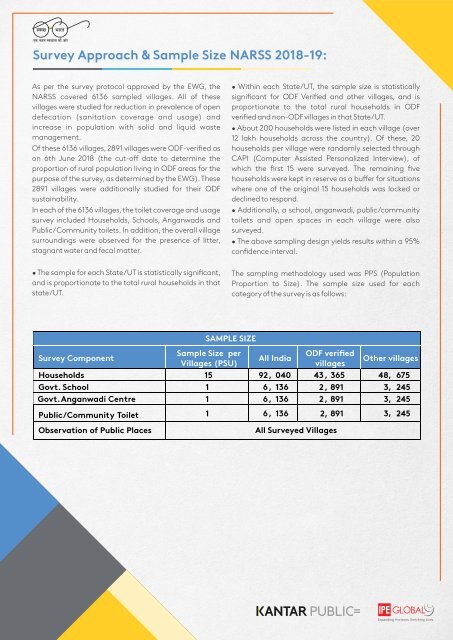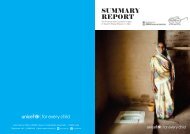Ministry of Jal Shakti, National Annual Rural Sanitation Survey, 2018-19
- No tags were found...
You also want an ePaper? Increase the reach of your titles
YUMPU automatically turns print PDFs into web optimized ePapers that Google loves.
<strong>Survey</strong> Approach & Sample Size NARSS <strong>2018</strong>-<strong>19</strong>:<br />
As per the survey protocol approved by the EWG, the<br />
NARSS covered 6136 sampled villages. All <strong>of</strong> these<br />
villages were studied for reduction in prevalence <strong>of</strong> open<br />
defecation (sanitation coverage and usage) and<br />
increase in population with solid and liquid waste<br />
management.<br />
Of these 6136 villages, 2891 villages were ODF-veri ed as<br />
on 6th June <strong>2018</strong> (the cut-o date to determine the<br />
proportion <strong>of</strong> rural population living in ODF areas for the<br />
purpose <strong>of</strong> the survey, as determined by the EWG). These<br />
2891 villages were additionally studied for their ODF<br />
sustainability.<br />
In each <strong>of</strong> the 6136 villages, the toilet coverage and usage<br />
survey included Households, Schools, Anganwadis and<br />
Public / Community toilets. In addition, the overall village<br />
surroundings were observed for the presence <strong>of</strong> litter,<br />
stagnant water and fecal matter.<br />
• Within each State/UT, the sample size is statistically<br />
signi cant for ODF Veri ed and other villages, and is<br />
proportionate to the total rural households in ODF<br />
veri ed and non-ODF villages in that State/UT.<br />
• About 200 households were listed in each village (over<br />
12 lakh households across the country). Of these, 20<br />
households per village were randomly selected through<br />
CAPI (Computer Assisted Personalized Interview), <strong>of</strong><br />
which the rst 15 were surveyed. The remaining ve<br />
households were kept in reserve as a bu er for situations<br />
where one <strong>of</strong> the original 15 households was locked or<br />
declined to respond.<br />
• Additionally, a school, anganwadi, public/community<br />
toilets and open spaces in each village were also<br />
surveyed.<br />
• The above sampling design yields results within a 95%<br />
con dence interval.<br />
• The sample for each State/UT is statistically signi cant,<br />
and is proportionate to the total rural households in that<br />
state/UT.<br />
The sampling methodology used was PPS (Population<br />
Proportion to Size). The sample size used for each<br />
category <strong>of</strong> the survey is as follows:<br />
<strong>Survey</strong> Component<br />
SAMPLE SIZE<br />
Sample Size per<br />
Villages (PSU)<br />
All India<br />
ODF veri ed<br />
villages<br />
Other villages<br />
Households 15 92, 040 43 , 365 48, 675<br />
Govt. School 1 6 , 136 2 , 891 3, 245<br />
Govt.Anganwadi Centre 1 6 , 136 2 , 891 3, 245<br />
Public/Community Toilet 1 6 , 136 2, 891 3, 245<br />
Observation <strong>of</strong> Public Places<br />
All <strong>Survey</strong>ed Villages




